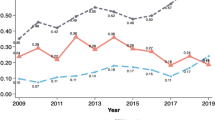Abstract
Mathematical models for practical calculations of technological progress (total productivity of production factors) and economic growth in the era of widespread digitalization and robotization of national economies, where the main factor of production is technological information, are developed and verified. For this purpose, models using different modes of information production are proposed for the first time. It is shown that the economic effect of the digitalization of an economy will not come immediately, but with a lag of about eight years. For the US economy, forecast calculations show that this will happen in 2022–2026 with total productivity increasing by 1.1 percentage points up to 2.5% per year.
Similar content being viewed by others
References
E. Brynjolfsson and S. Adam, Wired for Innovation: How Information Technology Is Reshaping the Economy (MIT Press, Cambridge, Mass., 2010).
T. Bresnahan and M. Trajtenberg, J. Econ. 65 (1), 83–108 (1995).
E. Brynjolfsson and L. Hitt, Manage. Sci. 42 (4), 541–558 (1996).
R. Solow, New York Times Books Rev., July 12 (1987).
D. Jorgenson and K. Stiroh, Brookings Papers on Economic Activity (2000), Vol. 1.
D. Romer, Advanced Macroeconomics (McGraw-Hill Education, New York, 2011).
A. A. Akaev and V. A. Sadovnichii, Herald Russ. Acad. Sci. 86 (5), 371–383 (2016).
A. I. Yablonskii, Mathematical Models in Science Studies (Mysl’, Moscow, 1986) [in Russian].
G. I. Barenblatt, Scaling (Cambridge Univ. Press, Cambridge, Mass., 2003).
R. Kurzweil, The Singularity Is Near (Viking Books, New York, 2005).
B. M. Dolgonosov, Nonlinear Dynamics of Ecological and Hydrological Processes (Librokom, Moscow, 2009) [in Russian].
H. von Foerster, P. Mora, and L. Amiot, Science 132, 1291–1295 (1960).
S. P. Kapitsa, Essay on the Theory of Human Population Growth: Demographic Revolution and Information Society (Nikitskii Klub, Moscow, 2008) [in Russian].
L. E. Varakin, Information-Economic Law (MAS, Moscow, 2006) [in Russian].
Author information
Authors and Affiliations
Corresponding author
Additional information
Original Russian Text © A.A. Akaev, V.A. Sadovnichii, 2018, published in Doklady Akademii Nauk, 2018, Vol. 482, No. 3.
Rights and permissions
About this article
Cite this article
Akaev, A.A., Sadovnichii, V.A. Mathematical Models for Calculating the Development Dynamics in the Era of Digital Economy. Dokl. Math. 98, 526–531 (2018). https://doi.org/10.1134/S106456241806011X
Received:
Published:
Issue Date:
DOI: https://doi.org/10.1134/S106456241806011X




